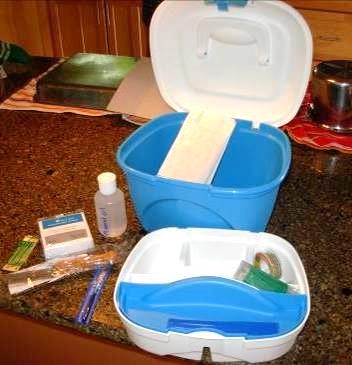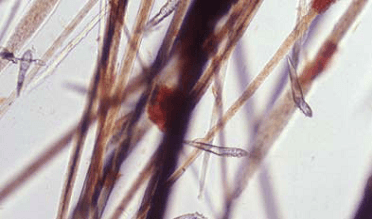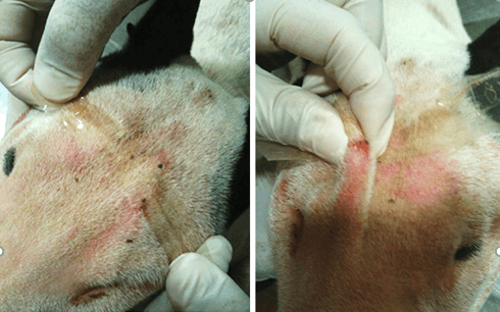Michele Rosenbaum, VMD, DACVD and Dana Liska, DVM, DACVD
Meet Gracie, a 9-year-old female spayed mixed-breed dog.
You can tell by those eyes that Gracie is a sweet girl. Her veterinarian, Dr. Taylor, describes her as friendly and generally calm during her dermatology examinations. According to Gracie’s owner, Campbell, her stress escalates and she becomes anxious and unsure when veterinary procedures are done.
Gracie came to see Dr. Taylor while experiencing a recent flare of pruritus and redness on her skin; she is allergic to red cedar and it was pollinating at the time. Campbell premedicated Gracie with anxiolytic medications before visiting the veterinary clinic because the medications appear to help Gracie feel calm and relaxed during her exams, especially when procedures like skin scraping and cytology are necessary.
Dermatologic diseases are often chronic and recurrent. In-hospital procedures like skin scrapes and skin and ear cytology are repeated on the same patient on multiple visits throughout the patient’s life. Veterinarians and staff must not induce fear, anxiety, and stress (FAS) responses because they may cause pet owners to avoid rechecks and needed treatment, negatively impacting the patient and pet owner’s emotional well-being.1
Karla, the veterinary technician who took care of Gracie, knows Gracie gets nervous during procedures and wanted to help. Here is what she did to prepare:
- Made sure pheromone diffusers were actively working in the exam room. Karla and Dr. Taylor also sprayed pheromones on their clothing and on the fluffy fleece blanket that Gracie would stand on during her procedure.
- She had Gracie’s favorite braunschweiger crumbles in her pocket and an adhesive lick mat with spray cheese ready to feed Gracie during the exam.
- Karla stocked a dermatology toolbox with all the supplies they would need in the exam room for dermatology diagnostics (flea comb, #10 blades or spatula, mineral oil, glass slides, cover slips, clear tape, gloves, cotton swabs, culturettes, alcohol wipes). This reduced the need for staff to go in and out of the room looking for supplies and eliminated the need to move patients to the treatment room, which can further escalate the pet’s FAS.

Dr. Taylor started with the least invasive techniques first (cytology) and left the more invasive techniques (skin scrapings) for last. To distract Gracie, Dr. Taylor gently scratched her adjacent to the area where she wanted to collect the impression smear sample or skin scrape. All the while Karla fed Gracie tasty treats from her hand or let her lick spray cheese from the adhesive lick mat. When Gracie stopped eating and looked anxious, Dr. Taylor stopped the procedure and took a break until Gracie was calm and eating again.
Gracie does not like skin scrapings and pulls away, so a hair pluck was done instead. Hair plucking or tape impressions are alternatives to skin scraping for Demodex in sensitive areas (periocular, paws). These techniques cause less discomfort and require less restraint, reducing FAS. Use curved mosquito hemostats to quickly and gently pluck 10 to 20 hairs from the lesion, then examine in mineral oil.

Dr. AV Peiriera
For the tape technique, press clear tape onto the skin and squeeze the tape and skin for 2-3 seconds, 2-4 times; then peel off the tape and place onto a glass slide.

Dr. AV Peiriera
If you find mites with hair plucking or tape impressions, there is no need to scrape at all. If no mites are found, you can then decide if returning for deep scraping, using sedation and pain control, is needed to rule out mites.1
Gracie’s ears were itchy and had brown discharge, so Dr. Taylor collected samples for ear cytology. To do this, leave the ear in the relaxed position and enter the center of the canal lumen and rotate in the lumen. Avoid scraping the side of the canal or trying to remove debris with the cotton swab, which can lead to canal erosions and FAS.2
Patient and gentle handling by technicians and veterinarians using Fear Free dermatology procedure techniques can create a positive experience and minimize FAS in your dermatology patients.
References
- Angus, JC, VMX, 2019 Reducing FAS (v1.0) – p1/para1/lines9-11 (p.1)
- Angus, JC, VMX, 2019 Reducing FAS (v1.0) – p2/para2/lines6-8 (p.2)
This article was reviewed/edited by board-certified veterinary behaviorist Dr. Kenneth Martin and/or veterinary technician specialist in behavior Debbie Martin, LVT.


 Sponsored by our friends at Zoetis Petcare. APQ-01012R1
Sponsored by our friends at Zoetis Petcare. APQ-01012R1

